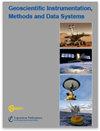走向经济实惠的3D物理为基础的河流流量评级:在卢安瓜河流域的应用
IF 2.3
4区 地球科学
Q3 GEOSCIENCES, MULTIDISCIPLINARY
Geoscientific Instrumentation Methods and Data Systems
Pub Date : 2023-08-21
DOI:10.5194/gi-12-155-2023
引用次数: 1
摘要
摘要无人驾驶飞行器(uav)、经济实惠的精确全球导航卫星系统硬件、多波束回声测深器、开源3D流体动力学建模软件以及免费提供的卫星数据,为一种强大的、经济实惠的、基于物理的河流流量监测方法提供了机会。传统的河流流量估算方法是基于点测量的,并且没有考虑到河流几何的异质性。相比之下,基于无人机的系统提供了另一种选择,该系统利用摄影测量捕获和合并的地理标记图像,以生成高分辨率数字高程模型(DEM)。这种无人机系统可以捕捉通道形状的空间变异性,用于输入水力模型,因此可能更准确的流量。简而言之,该系统可以以更高的分辨率产生河流几何形状,从而提高流量估计的精度。三维水动力模型提供了一个框架来建立河流流量和状态变量(如宽度和深度)之间的关系,而具有地表水探测方法或测高记录的卫星图像可用于通过已建立的评级曲线对流量进行操作监测。数据采集中的不确定性可能会传播到放电和状态变量之间关系的不确定性。在基于摄影测量的地形重建中,不同的地面控制点(GCP)密度和分布导致了所获得几何图形的变化。在这项研究中,我们利用经济实惠的数据收集方法和物理学的基本原理开发了一个评级曲线。基本原理包括合并基于摄影测量的干测深和使用声学多普勒电流分析器(ADCP)测量的湿测深。输出是一个无缝的水深测量,输入到水力模型中,以估计流量。研究了几何不确定性对放电估计的影响。分析了卫星观测深度和宽度的不确定性对卫星观测的影响。研究表明,3D模型与传统的河流流量估算结果具有可比性。基于三维水力建模的评级曲线与传统的基于测量的评级曲线相比,在95%的置信区间内。基于3d水力模型的估算需要在旱季和雨季结束时通过实地观测确定稳定河床和洪泛区内的粗糙度系数。此外,研究表明,超过最佳数的gcp密度变化对结果评级关系没有显著影响。最后,研究发现,哪个状态变量近似(水位和河宽)更准确取决于流量的大小。在数据有限的环境中,结合与阶段相适应的代理(洪泛区完全填满时的水位和洪泛区填满时的宽度)可以产生更准确的流量估计。该研究能够成功地应用先进的无人机和实时运动学定位(RTK)技术,通过水力建模进行精确的河流监测。这个系统可能并不比现场监测便宜;然而,它明显比其他系统更经济实惠,比如配备激光雷达的载人飞机。在本研究中,水力模型的标定是基于水面速度和水深。验证是基于rtk水线的目视检查。在未来的研究中,可以考虑更多的现场仪表读数,以优化验证过程。本文章由计算机程序翻译,如有差异,请以英文原文为准。
Towards affordable 3D physics-based river flow rating: application over the Luangwa River basin
Abstract. Uncrewed aerial vehicles (UAVs), affordable precise global navigation satellite system hardware, multi-beam echo sounders, open-source 3D hydrodynamic modelling software, and freely available satellite data have opened up opportunities for a robust, affordable, physics-based approach to monitoring river flows. Traditional methods of river discharge estimation are based on point measurements, and heterogeneity of the river geometry is not contemplated. In contrast, a UAV-based system which makes use of geotagged images captured and merged through photogrammetry in order to generate a high-resolution digital elevation model (DEM) provides an alternative. This UAV system can capture the spatial variability in the channel shape for the purposes of input to a hydraulic model and hence probably a more accurate flow discharge. In short, the system can be used to produce the river geometry at greater resolution so as to improve the accuracy in discharge estimations. Three-dimensional hydrodynamic modelling offers a framework to establish relationships between river flow and state variables such as width and depth, while satellite images with surface water detection methods or altimetry records can be used to operationally monitor flows through the established rating curve. Uncertainties in the data acquisition may propagate into uncertainties in the relationships found between discharge and state variables. Variations in acquired geometry emanate from the different ground control point (GCP) densities and distributions used during photogrammetry-based terrain reconstruction. In this study, we develop a rating curve using affordable data collection methods and basic principles of physics. The basic principal involves merging a photogrammetry-based dry bathymetry and wet bathymetry measured using an acoustic Doppler current profiler (ADCP). The output is a seamless bathymetry which is fed into the hydraulic model so as to estimate discharge. The impact of uncertainties in the geometry on discharge estimation is investigated. The impact of uncertainties in satellite observation of depth and width is also analysed. The study shows comparable results between the 3D and traditional river rating discharge estimations. The rating curve derived on the basis of 3D hydraulic modelling was within a 95 % confidence interval of the traditional gauging-based rating curve. The 3D-hydraulic-model-based estimation requires determination of the roughness coefficient within the stable bed and the floodplain using field observation at the end of both the dry and wet season. Furthermore, the study demonstrates that variations in the density of GCPs beyond an optimal number have no significant influence on the resultant rating relationships. Finally, the study observes that which state variable approximation (water level and river width) is more accurate depends on the magnitude of the flow. Combining stage-appropriate proxies (water level when the floodplain is entirely filled and width when the floodplain is filling) in data-limited environments yields more accurate discharge estimations. The study was able to successfully apply advanced UAV and real-time kinematic positioning (RTK) technologies for accurate river monitoring through hydraulic modelling. This system may not be cheaper than in situ monitoring; however, it is notably more affordable than other systems such as crewed aircraft with lidar. In this study the calibration of the hydraulic model is based on surface velocity and the water depth. The validation is based on visual inspection of an RTK-based waterline. In future studies, a larger number of in situ gauge readings may be considered so as to optimize the validation process.
求助全文
通过发布文献求助,成功后即可免费获取论文全文。
去求助
来源期刊

Geoscientific Instrumentation Methods and Data Systems
GEOSCIENCES, MULTIDISCIPLINARYMETEOROLOGY-METEOROLOGY & ATMOSPHERIC SCIENCES
CiteScore
3.70
自引率
0.00%
发文量
23
审稿时长
37 weeks
期刊介绍:
Geoscientific Instrumentation, Methods and Data Systems (GI) is an open-access interdisciplinary electronic journal for swift publication of original articles and short communications in the area of geoscientific instruments. It covers three main areas: (i) atmospheric and geospace sciences, (ii) earth science, and (iii) ocean science. A unique feature of the journal is the emphasis on synergy between science and technology that facilitates advances in GI. These advances include but are not limited to the following:
concepts, design, and description of instrumentation and data systems;
retrieval techniques of scientific products from measurements;
calibration and data quality assessment;
uncertainty in measurements;
newly developed and planned research platforms and community instrumentation capabilities;
major national and international field campaigns and observational research programs;
new observational strategies to address societal needs in areas such as monitoring climate change and preventing natural disasters;
networking of instruments for enhancing high temporal and spatial resolution of observations.
GI has an innovative two-stage publication process involving the scientific discussion forum Geoscientific Instrumentation, Methods and Data Systems Discussions (GID), which has been designed to do the following:
foster scientific discussion;
maximize the effectiveness and transparency of scientific quality assurance;
enable rapid publication;
make scientific publications freely accessible.
 求助内容:
求助内容: 应助结果提醒方式:
应助结果提醒方式:


